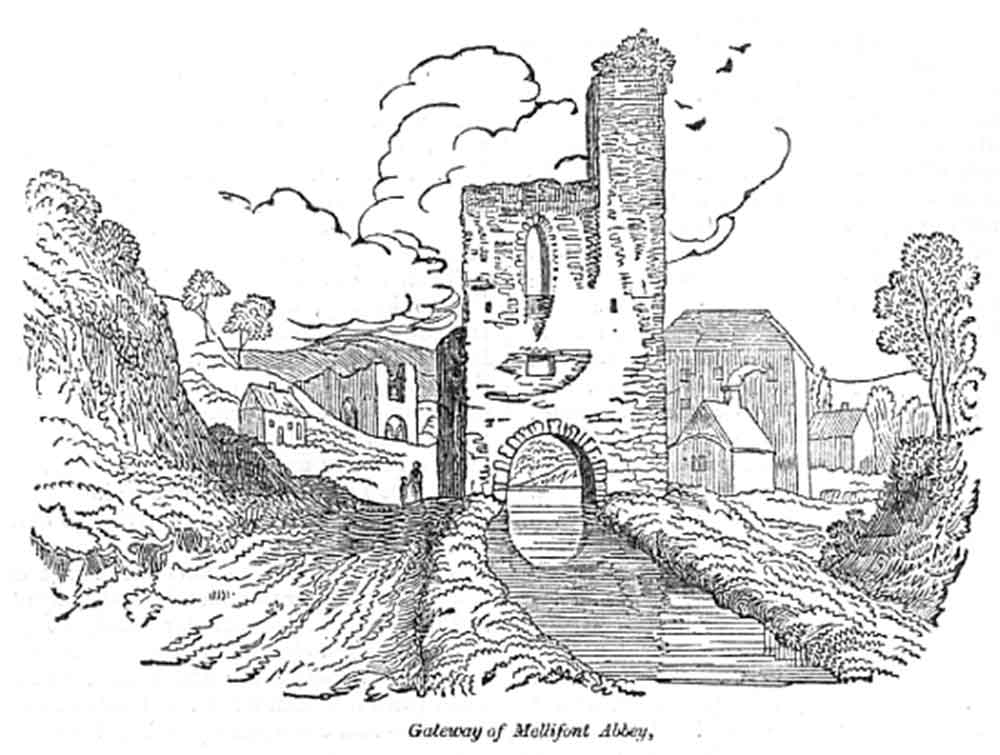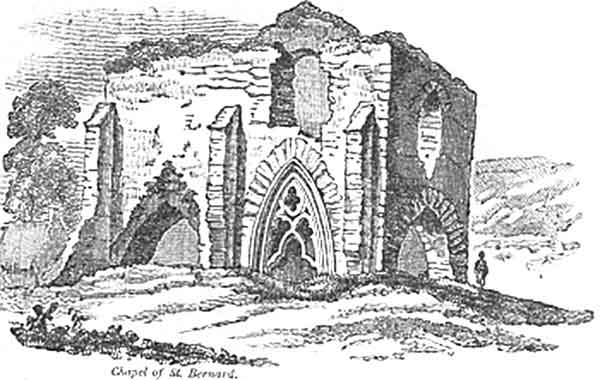Mellifont Abbey

Gateway of Mellifont Abbey
The Abbey of Mellifont, in the County of Louth, situate about five miles from Drogheda, in the Barony of Ferrard, was originally one of the most important and magnificent monastic edifices ever erected in Ireland.
It was founded, or endowed, by Donough M‘Corvoill, or O’Carroll, prince of Oirgiallach, the present Oriel, A.D. 1142, at the solicitation of St. Malachy, the pious and learned archbishop of Armagh, and was the first Cistercian Abbey erected in Ireland.
The monks by whom it was first inhabited were sent over from the parent Monastery of Clairvaux in Normandy, by St. Bernard, and four of them were Irishmen, who had been educated there for the purpose.
On the occasion of the consecration of the Church of Mellifont in 1157, a remarkable Synod was held here, which was attended by the primate Gelasius, Christian bishop of Lismore and apostolic legate, seventeen other bishops, and innumerable clergymen of inferior ranks.
There were present also Murchertach, or Murtogh O’Loghlin, King of Ireland, O’Eochadha, prince of Ulidia, Tiernan O’Ruaire, prince of Breiffny, and O’Kerbhaill, or O’Carroll, prince of Ergall, or Oriel.
On this occasion the King (Murtogh O’Loghlin) gave as an offering for his soul to God, and the Monks of Mellifont, 140 oxen or cows, 60 ounces of gold, and a townland, called Finnavair-na-ningen, near Drogheda.
O’Kerbhaill gave also 60 ounces of gold, and as many more were presented by the wife of Tiernan O’Ruaric, who was a daughter of the prince of Meath, that is a former prince Murchad. She likewise gave a golden chalice for the high altar, and sacred vestments. &c., for each of the nine other altars that were in the church.
This was the unfortunate Dearbhfhorguill, or Dervorgal, whose abduction by the profligate Dermod Mac Murrogh, King of Leinster, was the first link in the chain of events which led to the introduction into Ireland of the British arms, under the celebrated Strongbow.
Her pious donations to the abbey of Mellifont appear to have been in some measure intended as an expiation of her crime; and hither she retired towards the end of her life, which she closed in religious exercises about the year 1193.
It was supposed by some, but erroneously, as Dr. Lanigan satisfactorily shows, that here was held the Synod of 1152, at which Cardinal Paparo, as the legate of Pope Eugene III., distributed four Palliums for the sees of Dublin, Tuam, Armagh, and Cashel; it, however, was really held at Kells, in Meath.
On the establishment of the English power in the district called the Pale, in which Mellifont is situated, it was taken under the especial protection of the settlers.
In 1177 a confirmation of their house and possessions was granted by King Henry II. as appears by the Charter of his son John, who renewed and confirmed the same; and in 1203 a new charter was granted to the abbey by King John, confirming to it several additional possessions which it had acquired after the arrival of the English. Many other grants and confirmations were made by succeeding Princes.
For a considerable period the abbey of Mellifont, as well as the other Cistercian monasteries in Ireland, continued to be connected with the parent establishment at Clairvaux, to which monastery, considerable sums of money were continually remitted.
To correct this abuse, an act was passed in the reign of Edward III. enjoining all ecclesiastics not to depart the kingdom on any account whatsoever, nor to raise or transmit any sums of money privately or openly from hence, contrary to the form of the statute.
In consequence of this enactment, Reginald, the abbot of Mellifont, was by a jury in 1351, found guilty of raising from the abbots of Boyle, Knockmoy, Bective and Cashel, the sum of 664 florins, one half of which he had remitted to the abbot and convent of Clairvaux; and again, in the year 1370, the abbot, John Terrour, was similarly indicted for remitting to the same abbey the sum of forty marcs. This abbot was, in the year 1378, indicted for killing one of his monks, named John White, in the year 1367; but the jury acquitted him. In 1380, it was enacted by parliament that no mere Irishman should be permitted to make his profession in this abbey.
In 1488, the abbot received the king’s pardon for being concerned in support of Lambert Simnell.
In 1540, Richard Conter, the last abbot, surrendered his abbacy, and had an annual pension of £40. granted to him for life. He had 16 fishing corraghs or skin-boats at Oldbridge, on the Boyne, which produced him annually £13. 13s. 4d., which, with various other possessions, amounting in the whole to £315. 19s. were granted to Sir Edward Moore, (ancestor to the present noble family of that name,) who made it his principal seat, converting the abbey into a magnificent residence, and, at the same time, a place of defence.
In the memorable rebellion of 1641, a considerable body of the Irish sat down before it, and the garrison, which consisted of only 15 horse, and 22 foot, made a vigorous defence; but, on the failure of their ammunition, the foot surrendered, and the horse, charging vigorously through the enemy, arrived safe at Drogheda.
Such are the chief incidents in the history of this important monastic foundation, of which but trifling remains are now to be found, but these are sufficient evidence of its ancient beauty and splendour. They consist of the ruins of a beautiful little chapel, dedicated to St. Bernard, which in its perfect state was an exquisite specimen of the Gothic, or pointed architecture of the thirteenth century.

Chapel of St. Bernard, Mellifont Abbey
This chapel had a noble eastern window, and three smaller ones on each side, nearly all of which are now destroyed, together with the entrance doorway, of which we have given a view in our nineteenth number, page 148. This doorway was ornamented with a profusion of gilding, and painting in variegated colours, and was justly considered as one of the most beautiful specimens of the kind to be found in Ireland. It is said to have been sold to make a chimney piece!
Not inferior in architectural elegance to this chapel, are the ruins of an octagonal building, supposed a baptistery, on the top of which was a large cistern, from which water was conveyed by means of pipes, to the different offices of the abbey. The style of this building, which is Roman, indicates an earlier age, and it is probably coeval with the foundation of the monastery.
To these is to be added, the lofty abbey gateway, a view of which we have prefixed to this account; it is now appropriated to the humble purpose of a mill-dam.
The situation of these interesting remains, in a secluded little valley is extremely picturesque and pleasing; and there are many curious local traditions connected with them, but which we must reserve to a future number, along with a view of the baptistery.
P.
